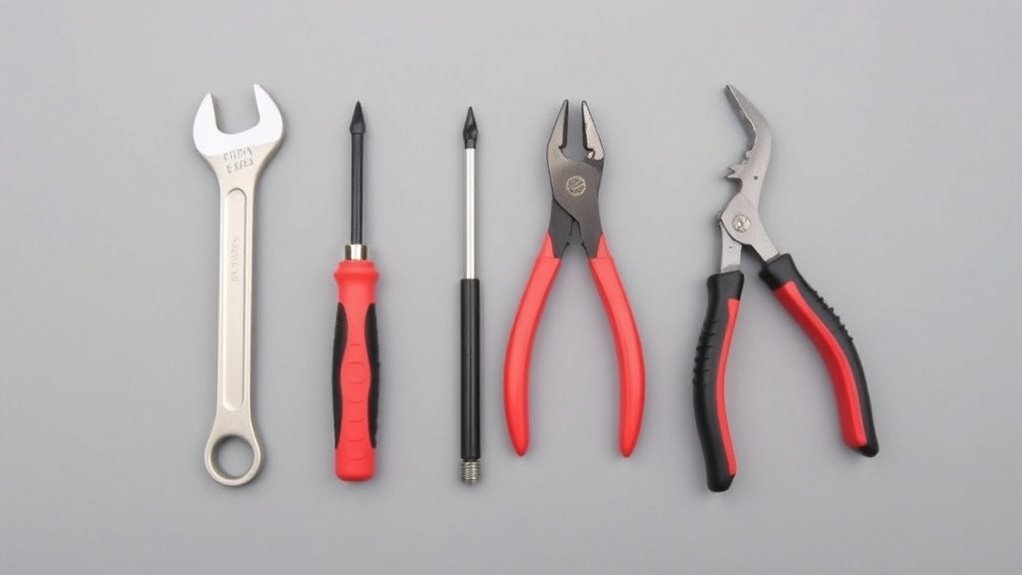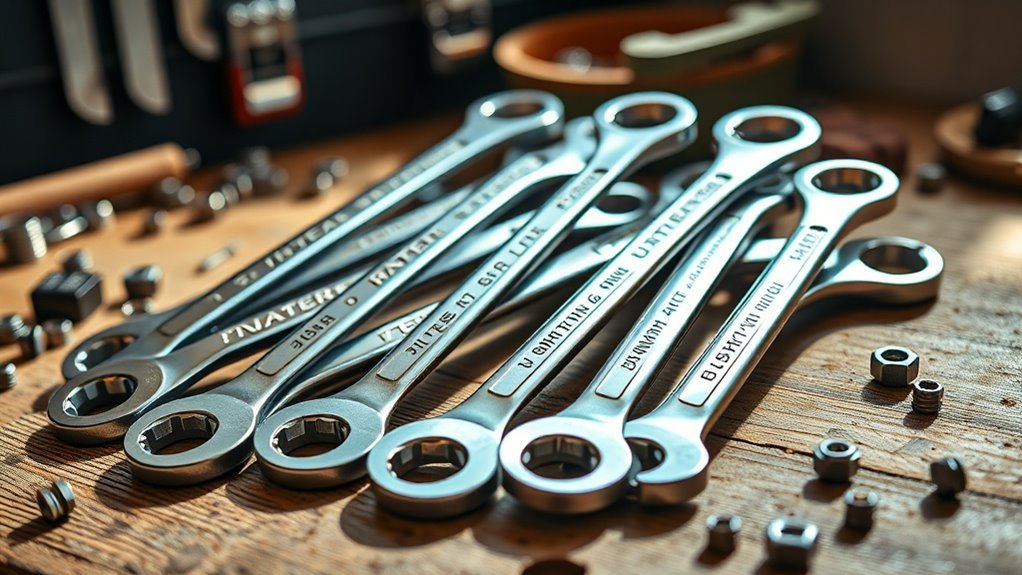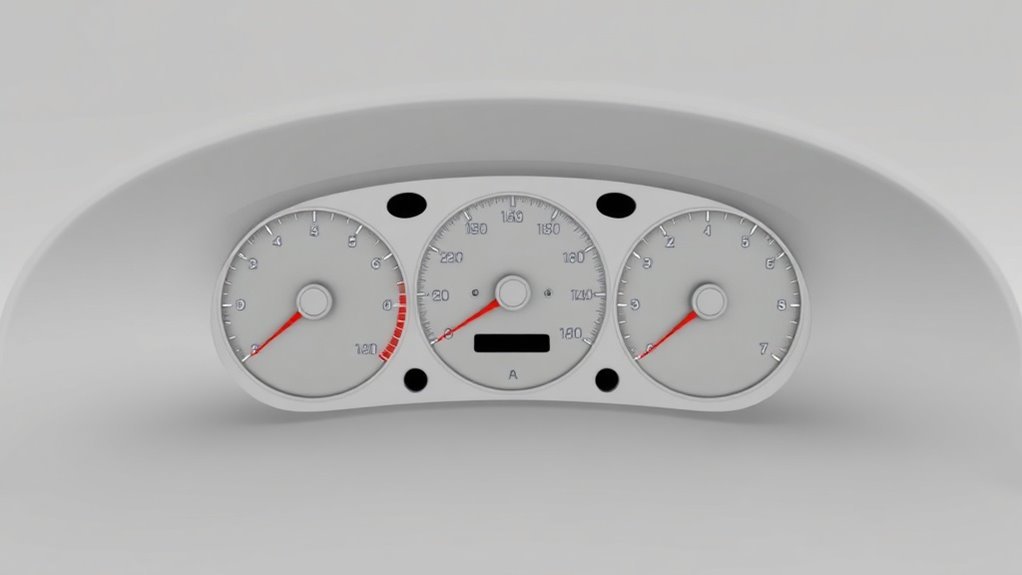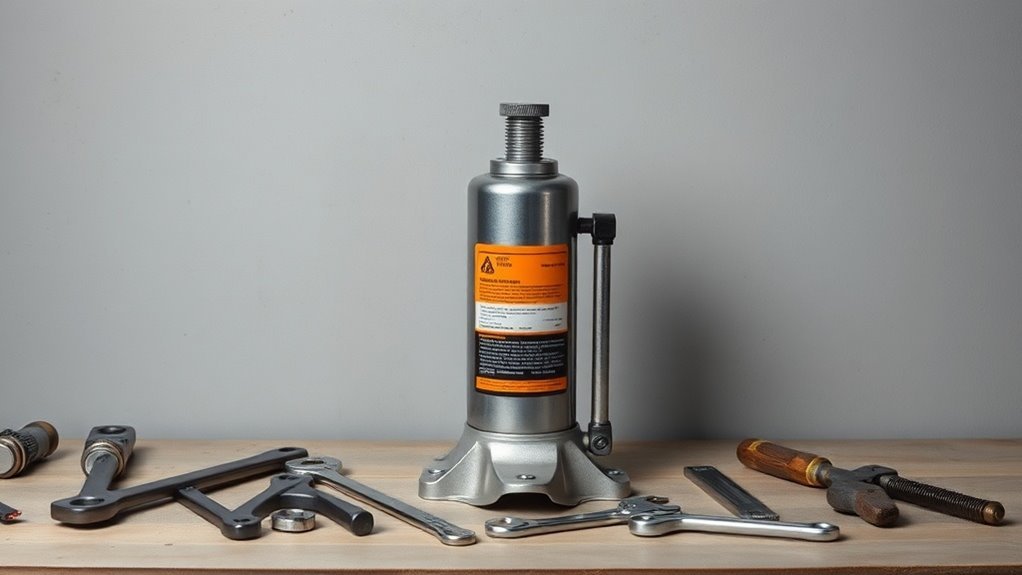Extension Cords and Power Safety for Workshops
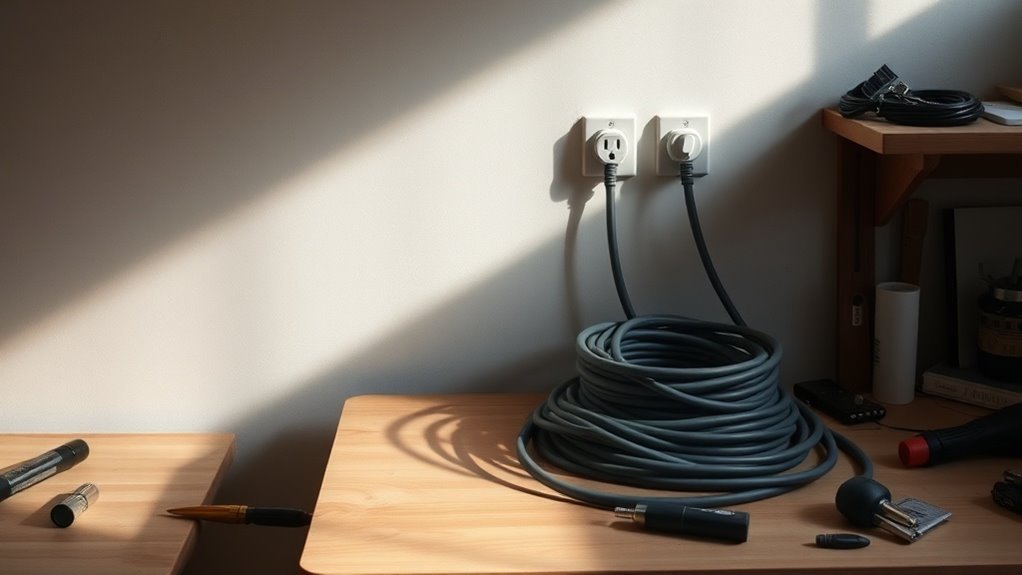
When using extension cords in your workshop, make sure to choose the right type and check the amperage and wattage to avoid overloading. Inspect cords for damage regularly and keep them away from water and obstacles to prevent electrical hazards and tripping. Always use grounded cords and secure them along walls. Proper storage helps prolong their life, too. There’s much more to ensuring safety; let’s explore some essential tips together.
Key Takeaways
- Always use grounded extension cords for safety when operating tools in workshops to prevent electrical shocks.
- Inspect cords regularly for damage and wear to identify potential hazards before use.
- Never exceed the cord’s amperage rating; check power requirements to avoid overheating and fire risks.
- Avoid daisy-chaining multiple cords together, as this increases the risks of electrical overload and fire hazards.
- Store extension cords properly, coiling them neatly to prevent kinks and ensure they remain in good condition.
Understanding Different Types of Extension Cords
When it comes to extension cords, you’ll find several types designed to meet different needs.
There’s the indoor extension cord, great for light use, like powering lamps or small appliances. Outdoor extension cords are built tougher, with weather-resistant features, perfect for yard work or outdoor events.
Indoor extension cords suit light use, while outdoor cords are rugged and weather-resistant for yard work and events.
Heavy-duty cords are designed for high-wattage tools and equipment, providing extra durability and safety. You’ll also encounter retractable cords, which offer convenience in workspace organization.
Don’t forget specialty cords, like flat cords that fit easily behind furniture or surge protector cords for added safety.
Always choose the right type for your task to guarantee safety and efficiency. Knowing the differences can help prevent accidents and enhance your overall experience.
Checking for Proper Amperage and Wattage
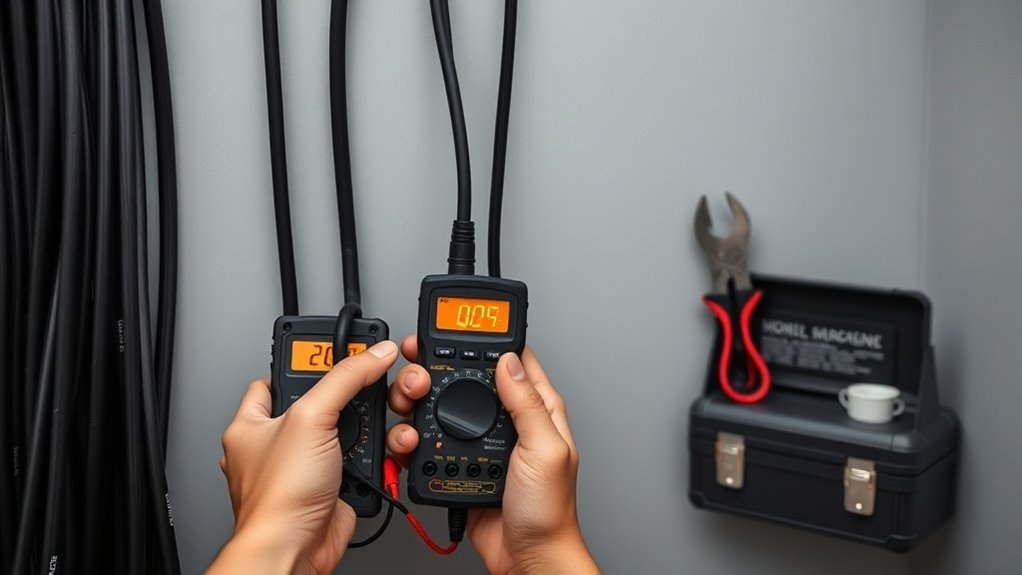
Ensuring the proper amperage and wattage is essential for safely using extension cords. Before plugging anything in, check the power requirements of your tools and equipment. You’ll find this info on the product label or in the user manual.
Then, compare those requirements to the specifications of your extension cord. Each cord has a maximum amperage rating, and exceeding it can lead to overheating or a fire hazard. Typically, most household extension cords can handle 10 to 15 amps.
Additionally, calculate the total wattage by multiplying the voltage by the amperage—make sure it doesn’t exceed the cord’s capacity. By being diligent about these basics, you’ll not only protect your equipment but also keep yourself safe while working in your workshop.
Selecting the Appropriate Length
When you’re choosing an extension cord, the length matters more than you might think.
You need to measure your work area size, factor in your tool power needs, and consider how much mobility you’ll require.
Getting the right length can help you work safely and efficiently without unnecessary hazards.
Measuring Work Area Size
To select the right length of extension cord for your work area, it’s crucial to measure the distance between your power source and the equipment you’ll use. Accurately measuring this distance guarantees you don’t end up with a cord too short or excessively long, which can create tripping hazards.
Here’s a quick reference table to help with sizing your extension cord:
| Distance (Feet) | Recommended Cord Length (Feet) |
|---|---|
| 0 – 25 | 25 |
| 26 – 50 | 50 |
| 51 – 75 | 75 |
| 76 – 100 | 100 |
| 100+ | 100+ |
Keep these guidelines in mind, and you’ll maintain a safe and efficient workspace.
Evaluating Tool Power Needs
After measuring the distance to your power source, the next step is to evaluate the power needs of your tools.
Choosing the right extension cord length is essential to guarantee peak performance and safety. Remember these key points:
- Tool Wattage: Check the wattage requirements of your tools. Higher wattage tools may require shorter cords to maintain power efficiency.
- Voltage Drop: Longer cords can cause a voltage drop, leading to reduced tool performance. Aim for a cord length that minimizes this effect.
- Circuit Load: Consider the total load on the circuit. If multiple tools will be used simultaneously, balance the load by selecting appropriate lengths and gauges for each tool.
Evaluating these factors will help ensure you’re using the correct cord length for safe and efficient operation.
Considering Mobility Requirements
While safety and power efficiency are essential, considering the mobility requirements of your workspace is just as important. You need to choose the right length of extension cord to guarantee you can access tools without stretching or tripping hazards.
Too short, and you might find yourself moving equipment around; too long, and you risk unnecessary tangles or voltage drop. As you assess your layout, consider the distance between power outlets and work areas. Think about how often you’ll be moving equipment or changing your setup.
Opt for a length that allows easy maneuverability while still maintaining safety. In the end, a well-chosen extension cord can enhance your workshop’s functionality and keep you focused on the tasks at hand.
Inspecting Cords for Damage
Before plugging in any extension cord, it’s crucial to inspect it for damage. A faulty cord can lead to severe accidents, so take a moment to perform a thorough check.
You should look for:
- Fraying or Cuts: Examine the entire length of the cord for any signs of wear or cuts. Even small nicks can be dangerous.
- Loose Connections: Make sure the prongs are securely attached to the cord. If they wiggle or feel loose, it’s time to replace it.
- Discoloration or Smell: If you notice any discoloration or a burnt smell, don’t use that cord. These could be signs of overheating and could risk a fire. Additionally, using circuit testers can help ensure that your electrical systems are operating correctly before use.
Avoiding Overloading the Circuit
To guarantee safety when using extension cords, you need to be mindful of the electrical load they can handle. Overloading a circuit can lead to overheating, which increases the risk of fires or equipment damage.
Always check the amp rating of your extension cord and verify it matches or exceeds the combined amperage of all devices you’re plugging in. It’s essential to avoid daisy-chaining multiple cords together, as this can exacerbate the risk of overload.
If you’re ever in doubt, unplug one device before adding another or use a more robust power strip with overload protection.
Positioning Cords to Prevent Tripping Hazards
When you’re using extension cords, think about where you place them to keep your space safe.
Using techniques like laying cords flat and employing cord covers can help minimize tripping hazards.
Plus, regular inspections guarantee your cords remain in good condition and don’t become a risk.
Optimal Cord Placement Techniques
Although it might seem like a minor detail, the placement of extension cords can considerably impact safety in any environment. By following some ideal cord placement techniques, you can minimize tripping hazards and keep your workspace safer.
Here are three key strategies to bear in mind:
- Route cords along walls: Whenever possible, run cords along the wall edges or behind furniture to keep them out of walking paths.
- Elevate where necessary: Use hooks or clips to elevate cords off the floor, especially in high-traffic areas.
- Avoid tight turns: Make sure cords are laid out in gentle curves rather than sharp angles, which can cause damage or increase the risk of accidents.
Use of Cord Covers
Using cord covers is one effective way to minimize tripping hazards in any space with extension cords. They help keep cords secure and out of the way, reducing the risk of slips and falls. When positioning your cords, it’s essential to use covers that are appropriate for your workshop’s layout.
Here’s a quick guide on cord cover benefits:
| Benefit | Description | Example |
|---|---|---|
| Safety | Reduces trip hazards | Covers placed on the floor |
| Protection | Guards cords from damage | Covers for heavy machinery |
| Organization | Keeps your workspace tidy | Neatly routes cables |
Regular Inspection and Maintenance
Regular inspection and maintenance of your extension cords is essential for guaranteeing safety and preventing tripping hazards.
You should make it a habit to routinely check your cords for any signs of wear and tear, guaranteeing a safer workspace.
Here are three key actions to take:
- Visual Inspections: Look for frayed wires, cracks, or exposed conductors. Any damage warrants immediate replacement.
- Proper Placement: Position cords along walls or use cord covers to minimize tripping risks. Avoid running them across high-traffic areas.
- Tight Connections: Guarantee plugs fit securely in outlets. Loose connections can create sparks or power interruptions.
Staying vigilant about these practices will keep your workspace safer and minimize unnecessary accidents.
Utilizing Grounded Cords and Outlets
When you’re dealing with electrical appliances, ensuring safety should always be a priority. One key aspect is utilizing grounded cords and outlets. Grounded cords, often featuring a third prong, help prevent electrical shocks by directing excess current to the ground.
Make sure all your tools and equipment use grounded cords, especially heavy-duty appliances, since they typically draw more power.
Whenever you set up your workspace, connect to grounded outlets. Avoid using ungrounded adapters, as they compromise safety. By choosing the right cords and outlets, you’re reducing the risks of electrical malfunctions and potential hazards.
Additionally, it’s wise to periodically inspect your cords for wear and tear to maintain their integrity. Regular maintenance of insulation effectiveness is crucial for avoiding potential hazards. Always prioritize grounded connections for a safer working environment.
Keeping Cords Away From Water and Obstacles
To guarantee electrical safety, keeping cords away from water and obstacles is essential. When extension cords come into contact with moisture or physical barriers, the risk of accidents increases considerably.
Here are a few tips to help you keep cords safe:
- Elevate Cords: Use cord management systems or cable trays to elevate cords above ground level, preventing potential water contact and tripping hazards.
- Avoid Wet Areas: Position cords away from sinks, pools, or other wet areas to minimize exposure to moisture that could lead to electrical shock.
- Clear Pathways: Regularly check and declutter your workspace, ensuring that cords are kept clear of heavy tools and equipment that could damage them or create tripping hazards. Additionally, understanding the principles of voltage, resistance, and current can further enhance your approach to safety when using electrical tools.
Safe Storage Practices for Extension Cords
Proper storage of extension cords is as important as keeping them safe from water and obstacles. To guarantee they remain in good condition, always coil your cords neatly after use, making figure-eight coils to prevent kinks and twists. Avoid wrapping them too tightly, as this can damage the internal wiring.
Store your cords in a dry, cool place, away from heat sources and direct sunlight. Consider using a dedicated storage container or a cord reel to keep everything organized. Label each cord if you’ve multiple lengths or types, so you’ll know exactly what you have.
Finally, check your cords periodically for wear or damage, and replace any frayed cords immediately to maintain safety in your workshop.
Questions
Can I Use Indoor Extension Cords Outside?
No, you shouldn’t use indoor extension cords outside. They’re not built to handle weather conditions, which could lead to damage, short circuits, or even fires. Always use outdoor-rated cords for safety and reliability.
What Gauge Wire Is Best for Heavy Tools?
For heavy tools, you’ll want to use a lower gauge wire, like 10 or 12 gauge. These thicker wires can handle higher currents safely, ensuring your tools get the power they need without overheating.
How Often Should I Replace My Extension Cords?
If you’re regularly using an extension cord for heavy tools, replace it every 3-5 years, or sooner if you notice frays, exposed wires, or any signs of wear. Safety first guarantees your projects stay incident-free!
Are There Extension Cords With Built-In Surge Protectors?
Yes, there are extension cords with built-in surge protectors. They help safeguard your devices from power surges, ensuring better protection. Just make sure to choose one that meets your specific power requirements and safety standards.
Is It Safe to Daisy-Chain Multiple Extension Cords?
Daisy-chaining multiple extension cords is like stacking firewood too high—it’s risky. You’re inviting overload, which can lead to overheating or even fires. Stick to one cord to keep your setup safe and sound.
Conclusion
In your workshop, extension cords serve as lifelines, powering your creativity and projects. Just like a sturdy bridge, they connect you to your tools, but they must be treated with care. By keeping cords safe and organized, you guarantee a smooth path free from hazards. So, as you plug in and release your imagination, remember that respecting these essential connections safeguards not just your workshop, but your inspiration, allowing your ideas to truly shine without being held back.

